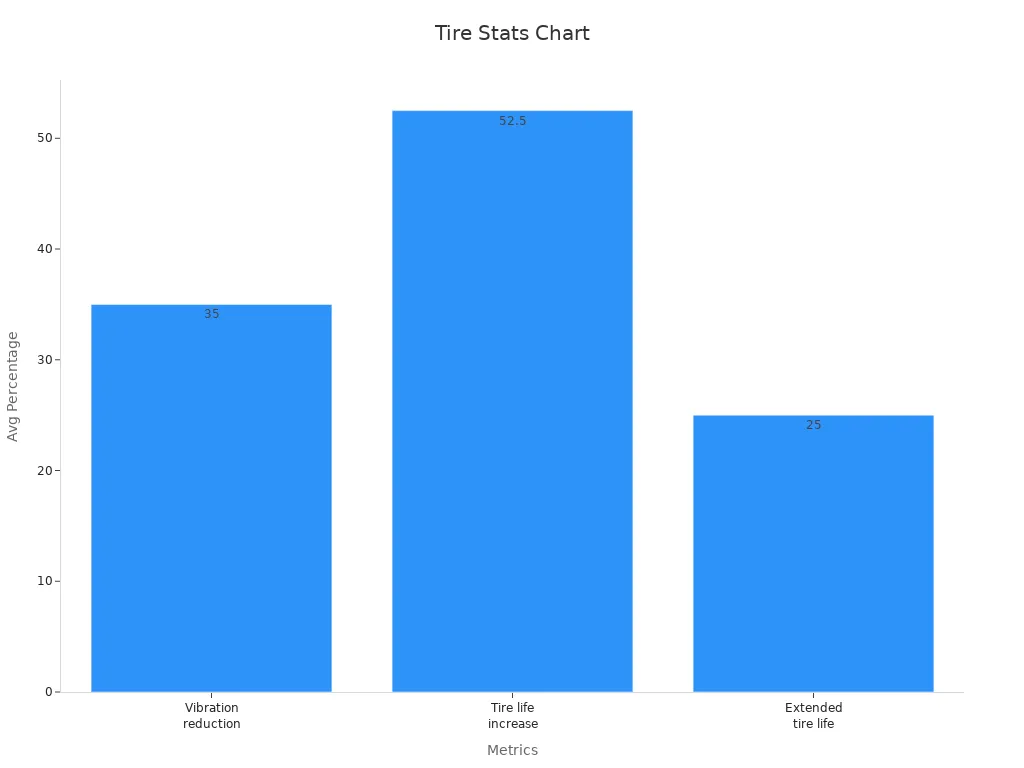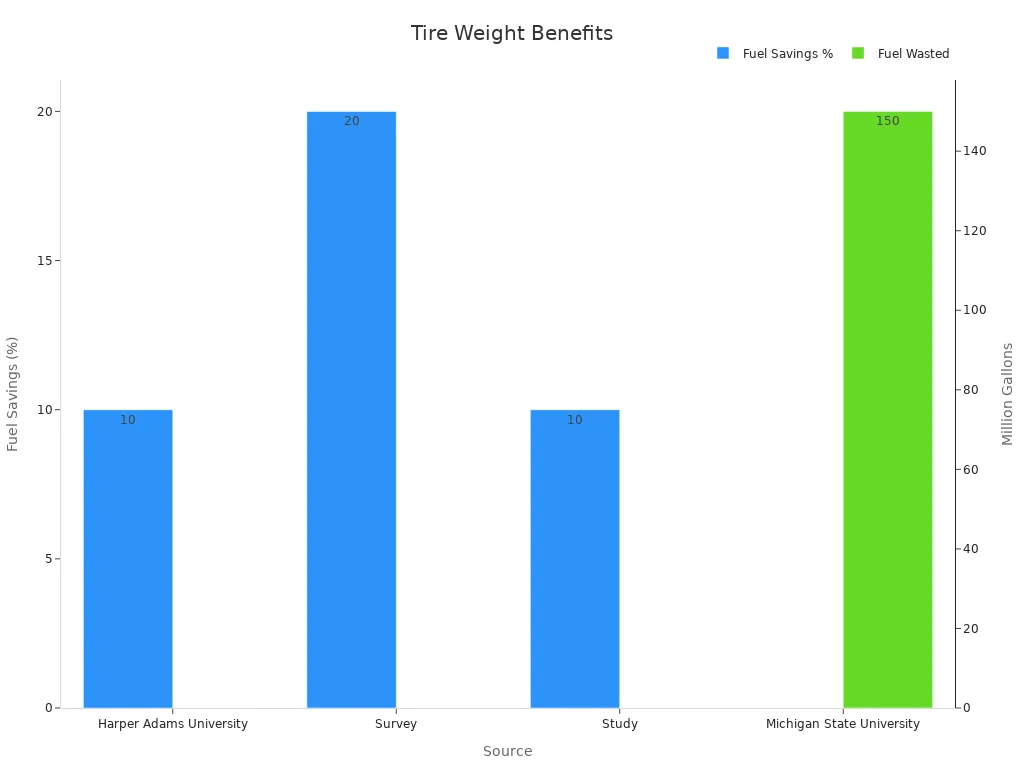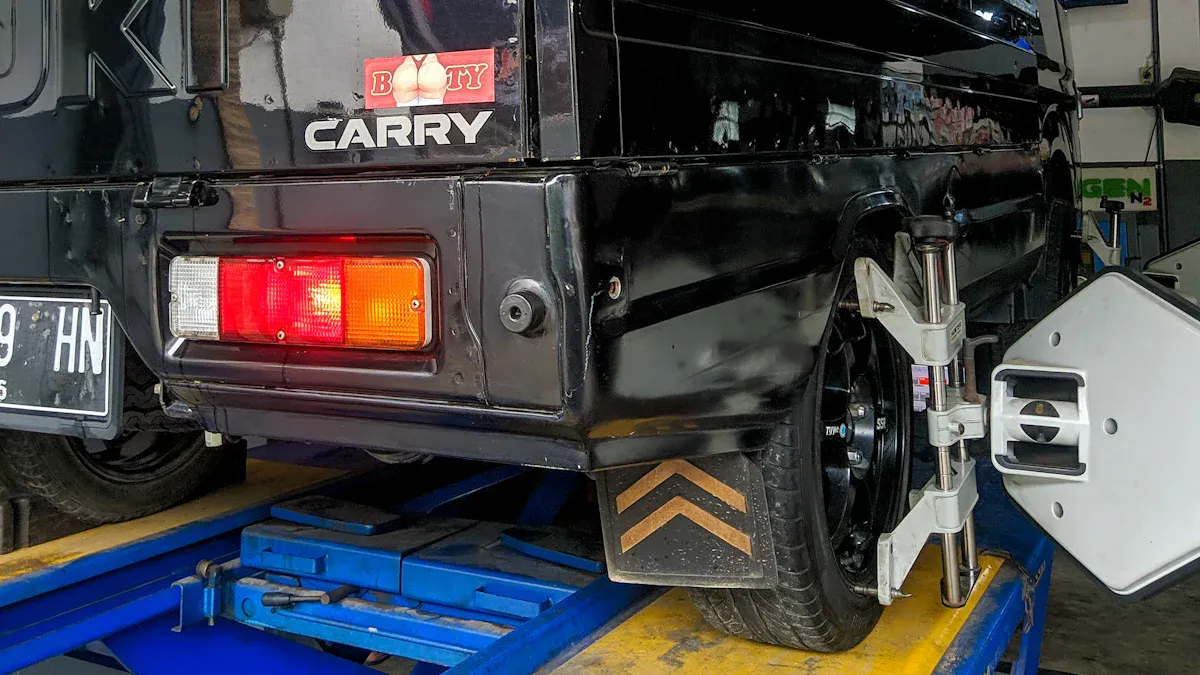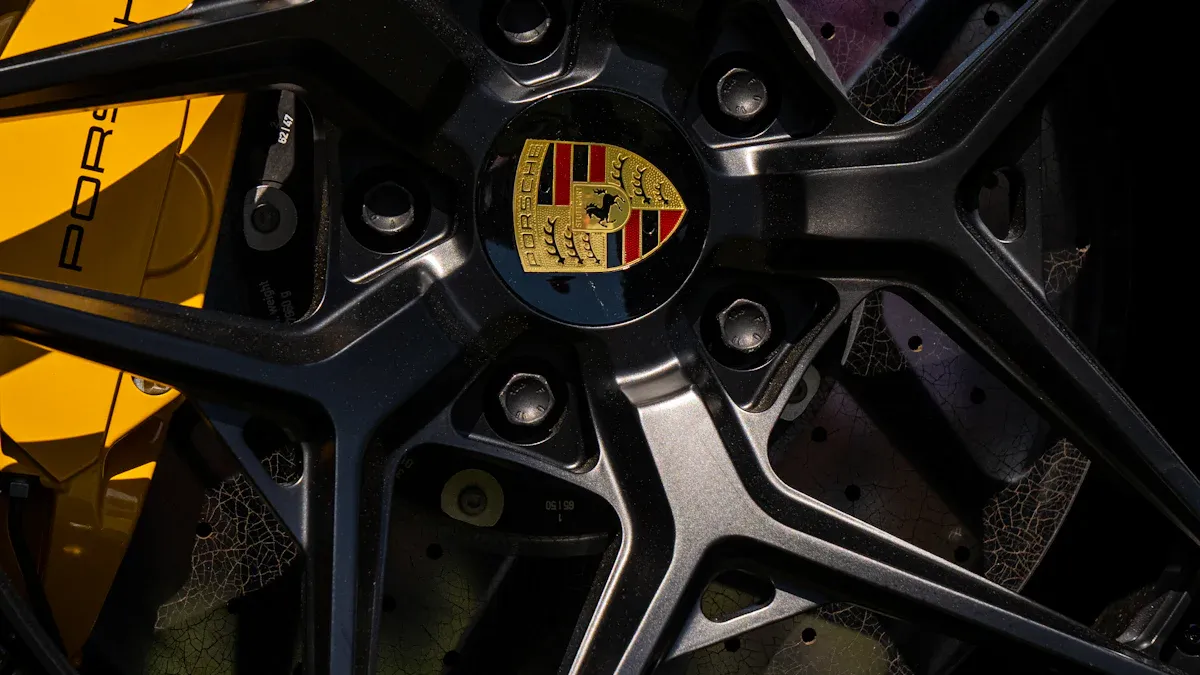

fortuneau
June 25, 2025
Tire and Wheel Weight Tips for Achieving Smooth, Balanced Rides

You want every ride to feel smooth and safe. Choosing the right wheel weight matters more than you might think. When you use the correct wheel weights, you cut down on vibrations, boost your safety, and help your tires last longer. Just look at the numbers: balanced tires can reduce vibration by up to 50% and increase tire life by as much as 80%.

Passenger vehicles lead the market, making up 61% of all tire and wheel weight needs. This shows how important selecting the right wheel weights is for everyday driving.
| Aspect | Data / Trend | Impact on Ride Balance |
|---|---|---|
| Market Size (2024) | USD 772.3 million | Shows strong demand for wheel weights |
| Passenger Cars Market Share (2024) | 61% | Most vehicles need regular balancing |
Selecting the right wheel weights keeps your ride steady and your tires in top shape.
Understanding Tire and Wheel Weight for Balance
The Importance of Wheel Weights in Tire Performance
You might not notice them, but wheel weights play a huge role in how your car feels on the road. When you use the right tire and wheel weight, you help your tires spin smoothly. This keeps your ride steady and safe. Wheel weights attach to the rim and help balance out any heavy or light spots in the tire and wheel. If you skip balancing, you can get bumpy rides, uneven tire wear, and even trouble with handling.
Let’s look at what happens when you focus on balance and proper wheel weights:
| Benefit Category | Description | Impact/Numbers |
|---|---|---|
| Safety and Handling | Balanced tires mean fewer accidents and better control | Up to 50% fewer winter accidents in Germany |
| Fuel Efficiency | Less rolling resistance saves gas | 2-4% better fuel economy |
| Ride Comfort & Stability | Less vibration means a smoother ride | 25.4% less vibration at highway speeds |
| Tire Longevity | Even wear helps your tires last longer | Up to 50% longer tire life |
| Cost Savings | Fewer replacements and less fuel used | Real savings over time |
You can see that the importance of wheel weights goes beyond just comfort. Balanced tires help you save money, stay safe, and enjoy every drive.
How Tire and Wheel Imbalance Impacts Ride Quality
When your tire and wheel weight is off, you feel it right away. An unbalanced tire-wheel assembly can cause your steering wheel to shake or your seat to vibrate. Sometimes, your car might even pull to one side. These problems make driving less fun and can even be dangerous.
Unbalanced wheels put extra strain on your suspension and brakes. You might notice your car takes longer to stop or feels harder to steer. Over time, this can wear out your tires faster and cost you more in repairs. Studies show that even a small imbalance can increase fuel use and make your ride rougher.
Tip: If you feel vibrations at certain speeds, it’s time to check your wheel balancing. Proper balancing keeps your tires in top shape and your ride smooth.

Balancing your tire and wheel weight helps you get better handling, safer stops, and a more comfortable drive. You protect your tires, save on gas, and keep your car running its best.
Types of Wheel Weights and Materials

Clip-On Wheel Weights vs. Adhesive Wheel Weights
When you balance your wheels, you usually pick between clip-on weights and adhesive wheel weights. Clip-on weights snap right onto the rim. You need special tools for this job, so most people let a pro handle it. These weights stay put, even if you drive on rough roads or through salty water. Many heavy-duty vehicles and trucks use clip-on weights because they last a long time and handle tough conditions.
Adhesive wheel weights, sometimes called stick-on weights, use a strong glue to attach to the inside of the wheel. You can install them at home if you clean the wheel first. These weights work great for alloy wheels and keep your rims looking sharp. They hide inside the wheel, so you get a clean look. Some drivers like adhesive wheel weights for high-performance cars or when they want to avoid scratches on the rim.
| Performance Aspect | Clip-On Weights | Adhesive Wheel Weights |
|---|---|---|
| Installation | Needs tools, pro install | DIY friendly, needs clean surface |
| Durability | Very high, resists harsh conditions | Good, but glue can weaken in heat/moisture |
| Rim Compatibility | May scratch alloy rims | Gentle on rims, keeps polished look |
| Aesthetics | Visible on rim | Hidden inside wheel |
| Best Use | Heavy-duty, rough terrain, steel wheels | Alloy wheels, performance, clean look |
Steel, Zinc, and Lead-Free Wheel Weight Options
You have a few choices when it comes to wheel weight materials. Steel wheel weights are strong and cost less. If coated, they resist rust for up to 3,000 hours in salt-spray tests. Zinc wheel weights offer even better corrosion resistance. They work well in wet or salty places and are safe for the environment. Lead wheel weights used to be common, but most shops avoid them now. Lead can pollute the ground and water, so many places ban it.
Check out this table for a closer look:
| Material | Performance Highlights | Durability | Cost | Environmental Impact |
|---|---|---|---|---|
| Steel | Strong, durable, needs coating | High (if coated) | Low | Very low, recyclable |
| Zinc | Great corrosion resistance | High | Medium | Low, recyclable |
| Lead | Not used much, pollution risk | Medium | Low | High, toxic |
Note: Most automotive wheel weights today use steel or zinc to protect your health and the planet.
Pros and Cons of Different Wheel Weights
Each wheel weight type has its own strengths. Clip-on weights give you top durability and stay attached even in harsh weather. You might see them on trucks or cars that drive on rough roads. But they can scratch your rim if not installed carefully. Adhesive wheel weights are easy to use and keep your wheels looking clean. They work best for alloy wheels and high-performance cars. Sometimes, the glue can weaken if it gets too hot or wet.
Steel wheel weights save you money and last a long time, especially with a good coating. Zinc wheel weights cost a bit more but fight off rust and work well in tough climates. Lead wheel weights are cheap, but they harm the environment, so most people skip them.
If you want the latest in wheel technology, carbon fiber and composite wheel weights offer huge weight savings—up to 80% less than steel. These advanced materials also reduce stress and deformation, making your ride smoother and your wheels last longer.
Tip: Always pick wheel weights that match your driving style, wheel type, and local weather. This helps you get the best balance, safety, and tire life.
How to Choose the Right Wheel Weight for Your Tire
Factors: Vehicle Type, Wheel Size, and Driving Needs
Picking the right wheel weight starts with knowing your vehicle and how you drive. Every car, truck, or SUV has different needs. You want your ride to feel smooth, safe, and steady. The right wheel weight helps you get there.
Here’s how you can break it down:
- Vehicle Type: Sedans, SUVs, hatchbacks, trucks, and electric vehicles all need different wheel weights. Sedans usually use lighter weights for better fuel economy. SUVs and trucks need heavier wheel weights to handle more weight and rough roads. Electric and hybrid cars often use special lightweight wheel weights to help with energy efficiency.
- Wheel Size and Weight: Bigger wheels need more weight to balance. Smaller wheels use less. The material of your wheel—steel or alloy—also changes what kind of wheel weight works best.
- Driving Needs: If you drive every day on city streets, you want a proper wheel weight that gives you a smooth ride and saves gas. If you go off-road or carry heavy loads, you need wheel weights that can handle bumps and extra stress.
Professional shops use special machines to measure exactly where your wheel needs balancing. These machines find the heavy or light spots and tell you the exact amount and position for your wheel weights. This process makes sure your wheel weights match your car’s needs, giving you better handling and less vibration.
Tip: If you drive fast or want top performance, you may need more precise balancing and special wheel weights. Always check your owner’s manual or ask a pro for advice.
Here’s a quick look at how these factors play out:
| Vehicle Type | Typical Wheel Weight Range | Wheel Size Influence | Balancing Method | Driving Needs Impact |
|---|---|---|---|---|
| Passenger Vehicles | 0.25 to 1 ounce | Smaller, lighter wheels | Static balancing | Everyday driving, smooth ride, fuel economy |
| Performance/Sports Cars | Less than 0.25 ounce | Lightweight, larger wheels | Dynamic balancing | High-speed handling, acceleration, cornering |
| Off-Road Vehicles | 1 to 2 ounces or more | Larger, stronger wheels | Static (mostly), some dynamic | Rugged terrain, load capacity, stability |
| Heavy-Duty Trucks | 2 to 3 ounces or more | Larger wheels, heavy tires | Dynamic balancing | Heavy loads, highway stability, fuel efficiency |
| Electric/Hybrid Vehicles | Under 1 ounce | Lightweight alloys | Dynamic balancing | Energy efficiency, range, smooth and quiet ride |
Passenger Cars and Everyday Tire Requirements
Most drivers use their cars for daily trips, errands, and commutes. If you drive a sedan or hatchback, you want a ride that feels smooth and safe. The right wheel weight keeps your tires balanced and helps your car handle well.
Studies show that tire size and weight matter a lot. For example, a common passenger car tire like the 235/55R19 has been tested using both computer models and real-world measurements. These tests prove that matching the tire’s weight and size with the proper wheel weight gives you the best balance and safety. When you use the right wheel weight, your tires wear evenly, your car uses less gas, and you get fewer vibrations.
Passenger cars usually need wheel weights between 0.25 and 1 ounce. Most shops use static balancing for these cars, which works well for everyday driving. The material of your wheel weight also matters. Steel and zinc wheel weights are popular because they last long and are safe for the environment.
| Parameter Category | Description | Key Findings |
|---|---|---|
| Tire Size & Weight | Example: 235/55R19 tire tested with real and simulated data | Tire and rim weights matched closely, showing the importance of correct wheel weight choice |
| Tire Modeling Approach | Rubber, steel, and aluminum alloy used in simulations | Realistic tire behavior linked to proper wheel weight and balance |
| Load & Inflation Effects | Tire stiffness and rolling resistance change with load and pressure | Proper wheel weight helps maintain stability and performance |
| Wheel Weight Standards | Wheel weights matched to manufacturer specs | Ensures safety and balance for passenger cars |
| Validation & Correlation | Tests follow ISO standards and real-world checks | Confirms the link between tire needs and wheel weight standards |
Note: Always check your tire size and follow the manufacturer’s recommendations for wheel weights. This helps you get the best balance and performance.
Performance, Off-Road, and Heavy-Duty Tire Considerations
If you drive a sports car, go off-road, or haul heavy loads, your wheel weight needs change. Performance cars need very precise balancing. Even a small mistake can affect handling at high speeds. These cars often use dynamic balancing and lighter wheel weights—sometimes less than 0.25 ounce—to keep the ride smooth and the steering sharp.
Off-road vehicles and heavy-duty trucks face rougher conditions. They need stronger wheels and heavier wheel weights—sometimes 2 to 3 ounces or more. These vehicles handle big bumps, heavy loads, and tough terrain. The right wheel weight keeps everything balanced, even when the road gets rough.
- Wheel load capacity tells you how much weight each wheel can safely carry. For example, a Toyota 4Runner TRD Pro with a rear axle rating of 3,439 lbs needs wheels rated for at least 1,719.5 lbs each.
- Off-road driving puts extra stress on your wheels. Impacts, weight shifts, and shocks mean you need wheel weights that can handle more force.
- Heavy-duty wheels often have their load ratings stamped on the back. Always check this before you buy new wheels or wheel weights.
- Reducing wheel weight by just 5-10 lbs per wheel can make a big difference. In one test, a 12 lb reduction per wheel improved a Miata’s 0-60 mph time by 0.29 seconds. Lighter wheels also help your suspension work better and improve fuel economy by up to 8%.
Callout: If you lift your truck or add bigger tires, you need to check your wheel weights and load ratings. Using the wrong wheel weight can lead to safety problems.
Performance and off-road drivers often choose steel or zinc wheel weights for strength and durability. Some use adhesive wheel weights for a cleaner look or to avoid scratching alloy wheels. Always match your wheel weight to your driving style and the demands of your vehicle.
Electric and Hybrid Tire and Wheel Weight Needs
When you drive an electric or hybrid vehicle, you face a unique set of challenges that make tire and wheel weight choices even more important. These vehicles look similar to regular cars, but their needs are different. Let’s break down why you need to pay special attention to your tire and wheel weight selection if you own an EV or hybrid.
Instant Torque and Tire Stress
Electric vehicles deliver power to the wheels instantly. When you press the accelerator, the car responds right away. This quick burst of power puts extra stress on your tires. If your wheel weights are not matched correctly, you might notice uneven wear or even a drop in performance. You want your tires to grip the road and handle the power without slipping or wearing out too fast.Heavier Vehicles, Higher Load Capacity
EVs and hybrids carry heavy battery packs. This extra weight means your tires must support more load than those on a gas-powered car. If you use the wrong wheel weights, your tires might not stay balanced, which can lead to a rough ride or even safety issues. Always check the load rating on your tires and make sure your wheel weights match the demands of your vehicle.Low Rolling Resistance for Efficiency
You want to get the most out of every battery charge. Low rolling resistance tires help you drive farther by reducing the energy needed to keep your car moving. The right wheel weights play a big part here. If your wheels are not balanced, your tires create more drag, which drains your battery faster and lowers your driving range.Special Tire Compounds and Tread Patterns
Electric and hybrid vehicles run much quieter than traditional cars. You might notice more road noise if your tires are not balanced well. Manufacturers use special rubber compounds and tread designs to keep things quiet and smooth. Proper wheel weights help these tires do their job, so you enjoy a peaceful ride.Regenerative Braking and Unique Wear Patterns
Regenerative braking helps you save energy by turning braking force into battery power. This system changes how your tires wear down. You might see different wear patterns compared to regular cars. Balanced wheels and the right tire choice help you handle these changes and keep your ride safe.Market Trends and Growing Demand
The US Electric and Hybrid Vehicles Market Report 2024 shows more people are choosing EVs and hybrids every year. As more drivers make the switch, the need for specialized tire and wheel weight solutions keeps growing. You want to make sure your car stays efficient, safe, and comfortable as the market evolves.
Tip: Always check your owner’s manual or talk to a tire professional before choosing new wheel weights for your electric or hybrid vehicle. The right choice can boost your car’s performance, extend your tire life, and help you get the most out of every charge.
Here’s a quick table to help you see the main differences:
| Feature | Electric/Hybrid Vehicles | Conventional Vehicles |
|---|---|---|
| Vehicle Weight | Heavier (due to batteries) | Lighter |
| Tire Load Capacity | Higher required | Standard |
| Rolling Resistance | Must be very low | Moderate |
| Tire Compound & Tread | Special for noise and grip | Standard |
| Braking System | Regenerative, unique wear | Traditional |
| Wheel Weight Selection | Precision needed for balance | Standard balancing |
| Performance Impact | Direct effect on range & safety | Affects comfort and wear |
You want your electric or hybrid car to run smoothly, save energy, and last a long time. The right tire and wheel weight choices help you reach those goals. Don’t overlook this step—your ride, your wallet, and the planet will thank you.
Recognizing When Your Tire Needs Balancing

Signs of Tire and Wheel Imbalance
You might not always notice when your tires lose their balance, but your car will give you some clear signs. If you pay attention, you can catch these problems early and keep your ride smooth.
Here are some common signs that your tires and wheels need balancing:
- Vibrations in the steering wheel, floor, or seats, especially when you drive faster.
- Uneven or accelerated tire wear. You might see one side of the tire wearing down more quickly.
- Your car pulls to one side or feels shaky when you steer.
- You hear thumping, humming, or buzzing sounds that get louder as you speed up.
- The steering wheel sits off-center, or the car wanders on the road.
You may notice these symptoms after hitting a pothole or curb, or after getting new tires. Sometimes, you feel the difference right after a tire rotation or repair. If you see any of these signs, it’s time to check your balance.
Experts recommend getting wheel balancing every 6,000 miles. This keeps your tires wearing evenly and helps your car handle better. When you bring your car in, a technician will use a special machine to spin your wheels and find any spots that need extra weight. They add small weights to fix the balance and stop the vibrations.
Tip: Regular balancing not only keeps your ride comfortable but also saves you money by making your tires last longer.
Benefits of Proper Tire and Wheel Weight Balancing
When you keep your tires and wheels in perfect balance, you get a lot of benefits. Your car feels smoother, and you stay safer on the road.
Here’s what you gain from proper balancing:
| Benefit | What You Experience |
|---|---|
| Smoother Ride | Less shaking and fewer vibrations |
| Longer Tire Life | Even tread wear, fewer replacements needed |
| Better Fuel Efficiency | Your car uses less gas |
| Improved Safety | More control, better handling |
| Quieter Driving | Fewer strange noises from your tires |
Balancing helps your tires roll smoothly, which means your car uses less energy. You get better gas mileage and save money at the pump. Even your steering feels lighter and more responsive. If you keep up with wheel balancing, you avoid costly repairs and enjoy a safer, more comfortable drive.
Remember: Tire balancing is a simple step that makes a big difference. Don’t wait for problems—make balancing part of your regular car care routine.
Installation and Maintenance of Wheel Weights
Step-by-Step Wheel Weight Installation Guide
Getting your wheel weights installed the right way makes a big difference in balancing and ride quality. You can follow these steps to make sure you get the best results:
- Clean the wheel surface before you start. Dirt or grease can stop the wheel weights from sticking or staying in place.
- Choose the proper wheel weight for your tire and wheel type. Stick-on weights work best for smooth, alloy wheels. Clip-on weights fit steel wheels and handle rough roads well.
- Use a balancing machine to find where the wheel needs weight. The machine will show you the exact spot for each weight.
- Attach the wheel weights. For stick-on types, press them firmly onto the clean surface. For clip-on types, use the right tool to snap them onto the rim.
- Double-check the balancing. Spin the wheel again to make sure you fixed the problem.
Tip: Modular and off-site installation methods, like using pre-made weights and sensor data, help make the process safer and faster. These steps lower the risk of mistakes and keep your wheels balanced longer.
Safety and Environmental Tips for Wheel Weights
You want your car to stay safe and the environment to stay clean. Using the proper wheel weight and handling it the right way helps both. Studies show that balancing with the right wheel weights improves your car’s grip, handling, and stability. You get smoother rides and better control, especially in tough conditions.
Always check that your wheel weights are tight and not corroded. Rust can make them fall off or stop working. If you see any damage, replace them right away. Avoid using lead wheel weights. Lead can harm people and wildlife. In North America, millions of pounds of lead fall off cars every year, causing pollution and health risks. Choose steel or zinc wheel weights instead. These are safer for you and the planet.
Note: Regular inspections and using non-lead wheel weights protect your family and the environment.
When to Seek Professional Tire and Wheel Weight Help
Sometimes, you need an expert for balancing and wheel weights. If you feel shaking, hear odd noises, or see uneven tire wear, a pro can help. Shops use advanced machines to check balancing and install the proper wheel weight. They know how to spot problems you might miss.
Check out this table to see how professional help improves your ride:
| Aspect Evaluated | Improvement / Finding | Impact on Ride Quality |
|---|---|---|
| Balancing Accuracy | Higher with professional tools | Smoother, safer ride |
| Tire Pressure | Checked and set correctly | Better fuel use and less tire wear |
| Wheel Weight Placement | Exact, based on machine readings | Less vibration and better handling |
You save time and avoid mistakes when you let a pro handle balancing and wheel weights. Your car feels better, and your tires last longer.
Choosing the right wheel weights makes a big difference in your daily drive. You get a smoother ride, better safety, and longer tire life. When you use wheel weights that fit your car and driving style, you lower vibration by up to 10%. You also cut shock exposure by half. Lighter wheel weights help your suspension react faster, so your tires grip the road better. Heavier wheel weights can make your ride rough and wear out your tires faster. Urban driving with lots of lane changes can wear tires quickly, but matching wheel weights to your habits helps. Studies show that lighter wheel weights improve handling and shorten braking distances. You want your wheel weights to keep your ride steady and safe. If you ever feel unsure, talk to a pro or reach out to a trusted company like Fortune. The right wheel weights keep you rolling smoothly every day.
- Proper wheel weights reduce whole-body vibration by 7-10%, making rides more comfortable.
- Vibrations drop by 35% and shock exposure by 50%, so you feel less strain.
- Lighter wheel weights help your suspension work better, improving grip and control.
- Heavier wheel weights increase tire wear and make rides less smooth.
- Matching wheel weights to your driving habits can slow down tire wear in city traffic.
FAQ
What happens if you drive with unbalanced wheels?
You’ll feel vibrations in your steering wheel or seat. Your tires may wear out faster. Unbalanced wheels can also make your car harder to control. Studies show that regular balancing can extend tire life by up to 50% and improve ride comfort.
How often should you balance your tires?
Most experts recommend balancing your tires every 6,000 miles or when you notice vibrations. If you hit a pothole or get new tires, check the balance right away. Regular balancing keeps your ride smooth and your tires in good shape.
Can you mix different types of wheel weights?
You shouldn’t mix clip-on and adhesive weights on the same wheel. Each type works best for certain wheels. Using only one type per wheel helps you get the best balance and keeps your wheels looking good.
Are steel and zinc wheel weights safe for the environment?
Yes! Steel and zinc wheel weights are both recyclable and much safer than lead. Many countries now ban lead weights because they pollute soil and water. Choosing steel or zinc helps protect your health and the planet.





